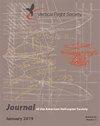Exploration on Nonaxisymmetric Flow Phenomenon in a Slinger Injector
IF 1.4
4区 工程技术
Q2 ENGINEERING, AEROSPACE
引用次数: 0
Abstract
The slinger is an important configuration of an aeroengine combustion chamber. It is well matched to smaller gas turbines that are more sensitive to cost than larger and more sophisticated models. The slinger combustor is inherently low cost itself, by eliminating fuel injectors and much of the fuel tubing and manifolding and also reducing costs in the requirements of the main fuel pump by operating at fuel delta pressures significantly lower than conventional fuel systems. The slinger's inherent drawbacks of increased combustion liner surface area and less atomization are less of a concern in a lower temperature, lower cost small turbines. The slinger's internal flow is of great significance to fuel atomization. This paper conducts experiments and numerical simulations on the slinger fuel injector. Numerical analysis and high-speed photography of the fuel slinger were applied to investigate the film flow pattern inside the slinger and the liquid phase distribution inside the combustion chamber to predict the flow field in an aeroengine combustion chamber. The transient Reynolds-averaged Navier–Stokes method, the volume of fluid method, and the discrete phase method were adopted in the simulation, and a high-speed camera and the rotational rig were used to perform the experiments. The nonaxisymmetric flow was present in the slinger and the combustor space. In the simulation results, the total mass-flow rate varies with time. Each hole's mass-flow rate value in the slinger is also different at the same time. The Sauter mean diameter (SMD) difference for each injection orifice is relatively small compared with the SMD difference caused by a rotation rate. The spatial distribution of the spray is also uneven as shown in the result of different single discharge channels' mass-flow rates. The experimental photos confirmed the simulation outcomes. The general theoretical analysis was made that these nonaxisymmetric phenomena were driven by the combined action of centrifugal force, surface tension, and instability phenomenon.斜杆喷射器非轴对称流动现象的探讨
弹弓是航空发动机燃烧室的重要结构。它与小型燃气轮机很好地匹配,这些燃气轮机比大型和更复杂的型号对成本更敏感。由于省去了燃油喷射器、大部分燃油管和歧管,该燃烧器本身成本就很低,而且通过在比传统燃油系统低得多的燃油δ压力下运行,降低了主燃油泵的成本。在较低温度、较低成本的小型涡轮机中,抛掷器增加燃烧衬板表面积和较少雾化的固有缺点较少受到关注。甩丸器的内部流动对燃油雾化具有重要意义。本文对悬挂式喷油器进行了实验和数值模拟。采用数值分析和高速摄影技术,研究了燃油甩丸器内的膜状流动模式和燃烧室内的液相分布,以预测航空发动机燃烧室内的流场。仿真采用瞬态reynolds -average Navier-Stokes法、流体体积法和离散相位法,采用高速摄像机和旋转平台进行实验。甩料筒和燃烧室空间存在非轴对称流动。在模拟结果中,总质量流量随时间变化。同时,每个井眼在甩尾器中的质量流量值也不同。与旋转速率引起的SMD差异相比,每个注射孔的Sauter平均直径(SMD)差异相对较小。由于单通道质量流量的不同,喷雾的空间分布也不均匀。实验照片证实了仿真结果。从理论上分析了这些非轴对称现象是由离心力、表面张力和不稳定现象共同作用的结果。
本文章由计算机程序翻译,如有差异,请以英文原文为准。
求助全文
约1分钟内获得全文
求助全文
来源期刊

Journal of the American Helicopter Society
工程技术-工程:宇航
CiteScore
4.10
自引率
33.30%
发文量
36
审稿时长
>12 weeks
期刊介绍:
The Journal of the American Helicopter Society is a peer-reviewed technical journal published quarterly (January, April, July and October) by AHS — The Vertical Flight Society. It is the world''s only scientific journal dedicated to vertical flight technology and is available in print and online.
The Journal publishes original technical papers dealing with theory and practice of vertical flight. The Journal seeks to foster the exchange of significant new ideas and information about helicopters and V/STOL aircraft. The scope of the Journal covers the full range of research, analysis, design, manufacturing, test, operations, and support. A constantly growing list of specialty areas is included within that scope. These range from the classical specialties like aerodynamic, dynamics and structures to more recent priorities such as acoustics, materials and signature reduction and to operational issues such as design criteria, safety and reliability. (Note: semi- and nontechnical articles of more general interest reporting current events or experiences should be sent to the VFS magazine
 求助内容:
求助内容: 应助结果提醒方式:
应助结果提醒方式:


